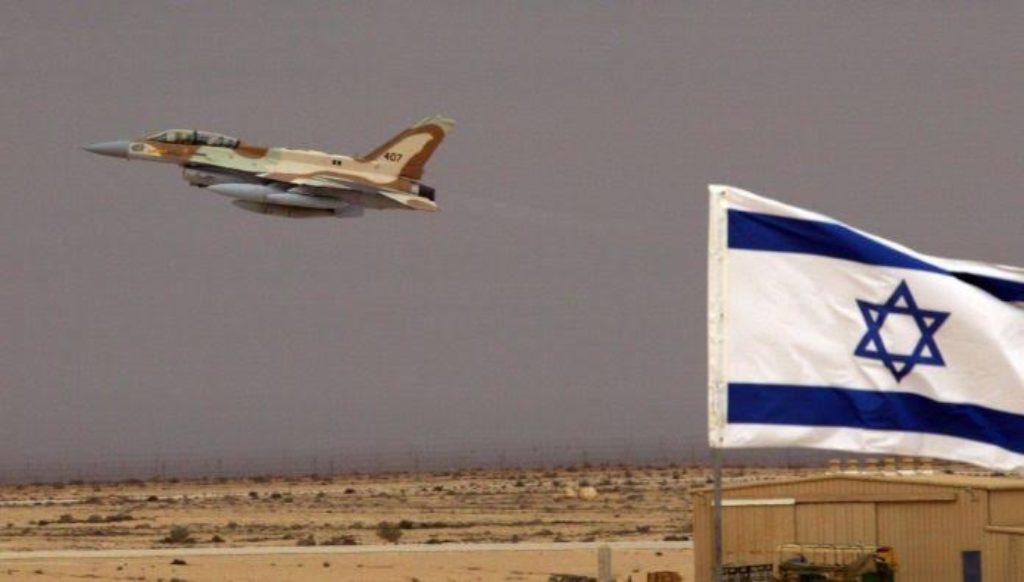Rocket alert sirens sounded in north eastern Israel Thursday night, shortly past midnight. News reports Friday morning revealed that the Israel Air Force had carried out strikes against several targets in the city of Palmyra, the deepest such raid into Syrian territory since the beginning of the Syrian civil war. The rockets that fell in Israel appear to have been Syrian anti-air missiles – likely Russian-made SA-5s – fired at the returning Israeli jets. The target of the strikes looks to have been a weapons shipment to Hezbollah at Palmyra’s T-4 military base. The incident is the most serious clash between Syria and Israel since the Syrian civil war broke out six years ago.
According the Lebanese Armed Forces (LAF), at 2:34 AM four Israeli jets flying at low altitude entered Lebanese airspace from the Mediterranean over the south Lebanese village of Al-Abbassiyeh. Though the LAF claims the jets turned back to Israel shortly afterwards, it appears they may have actually continued flying towards northeastern Lebanon. From there, according to the Syrian Arab Army (SAA), the jets entered Syria at 2:40 AM over the village of al-Bureij – across the border from northeastern Lebanon – and, using stand-off missiles, targeted a Syrian army position in the direction of Palmyra. Other pro-Assad sources claimed that nearby Beqaa Valley residents heard explosions at a target between the Lebanese border and Damascus. Though the Israeli army acknowledged – for the first time – that it had carried out the strike, it did not reveal any information on its targets.
Shortly after the strike had been carried out, Hezbollah sources announced the death of Badia’ Hamiyah, one of its field commanders in Syria, without acknowledging how he had been killed. This led some to draw a connection between his death and the IAF raid. Hezbollah’s Al-Mayadeen, however, denied Hamiyah was killed in the strike, claiming he was killed in Quneitra near the Israeli-Syrian border. Though, if the Hezbollah sources claims are true, it raises questions as to the presence of the group’s fighters on the Syrian side of the Golan Heights – particularly after recent claims by Hezbollah that it had finished preparing the Golan as a front in a future war against Israel.
One possibility is that the target of the Israeli strike was a weapons shipment to Hezbollah at the Syrian Army’s T-4 Airport in western Palmyra. The SAA, assisted by Hezbollah and the Russians, recently retook T-4 airport from ISIS, and the Shiite group continues to maintain a large presence there. It is likely that, since the Israelis continue to interdict weapons shipments to Hezbollah at Damascus Airport, the group has begun receiving shipments at T-4 thinking it was out of the IAF’s reach.
Israeli Prime Minister Benjamin Netanyahu’s statement in the wake of the strike serves to confirm this. “When we identify attempts to transfer advanced arms to Hezbollah, and we have intelligence information and we have the operational plan, we act to prevent it. That’s what happened and that’s what will happen,” said Netanyahu.
The Syrian army claims that, in the aftermath of the strike, its air defenses shot down one of the attacking Israeli jets and damaged another while the planes were over Israeli territory. IDF spokesmen denied these claims, saying one of the Syrian anti-air missiles were shot down by Israel’s Arrow missile defense system.
In another first, Israel’s ambassador to Moscow was summoned into the Russian Foreign Ministry to clarify his country’s actions. This comes shortly after Netanyahu returned from a visit to Moscow, where he discussed Israel’s concerns over Hezbollah and Iran’s growing power in Syria with Russian president Vladimir Putin. Israel’s Intelligence Minister commented that Jerusalem had acted without informing the Russians because Syrian President Bashar al-Assad was changing the rules of the game vis-à-vis Israel and allowing Syria to “become a dangerous hub of Hezbollah activity,”
Indeed, the Syrian air defenses’ response constitutes a serious development. During past Israeli strikes on Hezbollah, the Syrian army has largely stayed out of the fray. The contrast this time is a possible indication that the Assad regime perceives a positive change in its domestic fortunes, particularly after its success against rebel factions in the battle of Aleppo in December 2016.
It is doubtful that Assad was seeking a full-blown confrontation with the Israelis. More likely, he was simply trying to convey this regained confidence to his domestic foes, and also to signal to Israel that the IAF could no longer operate freely against Hezbollah in Syrian territory.








